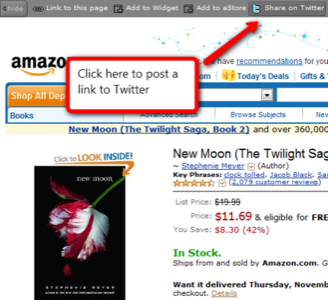Last night, Amazon sent out emails to their Amazon Associates members touting the latest addition to the company’s affiliate program: a new feature called “Share with Twitter.” According to the email, participants can generate “tweetable” links to any Amazon product after first logging into their Associates account. By clicking on the “Share with Twitter” button from any Amazon product details page, members are delivered to the Twitter.com website. Here, a shortened link and a bit of auto-populated text are automatically filled in Twitter’s “What are you doing?” text box. The included text can be edited to say whatever they want before posting or they can choose to just post as is. After updating Twitter, any person who clicks through on the link and makes a purchase will earn the participant referral fees payable through the Associates program.

Amazon Associates is Amazon’s affiliate program whose original purpose was to help website owners generate links and banner advertisements which they could embed on their sites in order to generate additional income. The links could be text, images, or combinations of both while the banners were always full-color ads branded with Amazon.com’s logo. For the most part, these sorts of advertisements are relatively easy to spot on participating blogs and websites. Save for the image links, which are just a picture of a product, everything else is clearly some sort of standard ad referring you to a particular product or service provided by Amazon.

The new Twitter links, however, are a whole new story. If an Amazon Associates member takes the time to re-write the text into their own words, there’s virtually no way to know by looking at the post that the Twitter update is actually an ad.
Is Amazon Spamming Twitter?
In the past, several legitimate companies have diluted the Twitter stream with promotions and contests encouraging Twitter users to “tweet to win” so to speak, by pasting in some sort of marketing message into the “What are you doing?” box or by appending a promotional hashtag to their everyday messages. But unlike these company-run Twitter promotions, there’s not a hashtag to use or any specific wording that has to be tweeted in order to participate in the Amazon Affiliate program. All anyone has to do is tweet links along with the message of their choosing.
Because Amazon’s marketplace is extensive in terms of the products it sells, there’s a wide variety of things which can be promoted. No matter what a Twitterer’s particular interest is: music, politics, technology, etc., there’s bound to be hundreds of things that could be mentioned in their Twitter stream without the posts appearing to be an ad. In fact, there’s a good possibility that they would have been talking about these products anyway throughout the course of the day…they just couldn’t have made any money off of them until now.
Hidden Advertisements
The problem with this sort of “hidden” advertising, though, is exactly that: it’s hidden. This is the internet’s version of “product placement” – subtle advertising in plain sight yet never clearly identified as such. Was your favorite TV star using a Macbook? Was he drinking a Coke? Already commonplace in Hollywood, these almost subliminal advertising messages permeate our consciousness every time we turn on the TV. Now that same sort of hidden ad will soon show up in the Twitter streams of your favorite tweeters.
Soon they’ll start promoting a great book they just read, a DVD they liked, or one of a million other things pulled out of Amazon’s vast inventory. None of it will sound out of place given the types of informal conversations that take place on Twitter every day. You won’t even know that they’re advertising to you until you click through on the link and find yourself on an Amazon.com webpage – and even then, you may not be sure. Was that a referral or were they genuinely just linking to the Amazon website to be helpful?


Will the FTC Step In?
Another question this raises, at least here in the U.S., is whether or not the FTC will get involved. Having recently taken steps to make sure that bloggers were properly disclosing freebies or payments received by companies whose products were being reviewed on their sites, one has to wonder if they’ll now be tempted to monitor the undisclosed advertising that’s about to explode on Twitter.
Amazon could have avoided the potential threat of government involvement (not to mention the accusations that they’re “spamming Twitter”) by generating their links using their own proprietary URL-shortening system, something like amzn.com or amz.com for example. That would clearly identify the tweets’ purpose. But instead, they opted to make their links with the URL shortener bit.ly, the one that Twitter itself uses by default. This makes the Amazon links indistinguishable at a glance from any other shortened link posted to Twitter. There’s no way to tell if a tweet is an ad unless the Twitter user left Amazon’s auto-generated text in place. Of course, no one is going to use that text except the laziest of Twitter spammers – people you’re probably already avoiding.
Tell Amazon What You Think with #AMZNSOT
Today, many Twitter users are coming out against this new type of Twitter-fueled advertising, registering their complaints via tweets marked with the #AMZNSOT hashtag, the official tag used to give Amazon feedback about the system. These users are already branding this new effort “spam,” saying things like: “Amazon now gives you cash for spamming on Twitter? Oh, swell,” as Twitter user TwitBin says. “Does this just mean more Twitter spam as people try to make money?” asks NickHerbert. But there are just as many Twitter users saying nice things about the new system too, calling it “cool,” “awesome,” “sweet,” and even claiming it “rocks.”
You can give Amazon your two cents as well by updating Twitter with your thoughts and including the #AMZNSOT hashtag along with your message.
Whether you think the new Amazon Twitter integration is good or bad, there’s no doubt that it will be a major game changer for Twitter. As it blurs the lines between conversation and ads, people seem to think that Amazon has either created something of genius or has ruined Twitter as we know it. Few seem to be undecided when it comes to their feelings about this issue. The question is now: which side will end up being in the majority?










